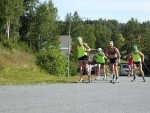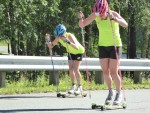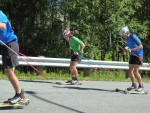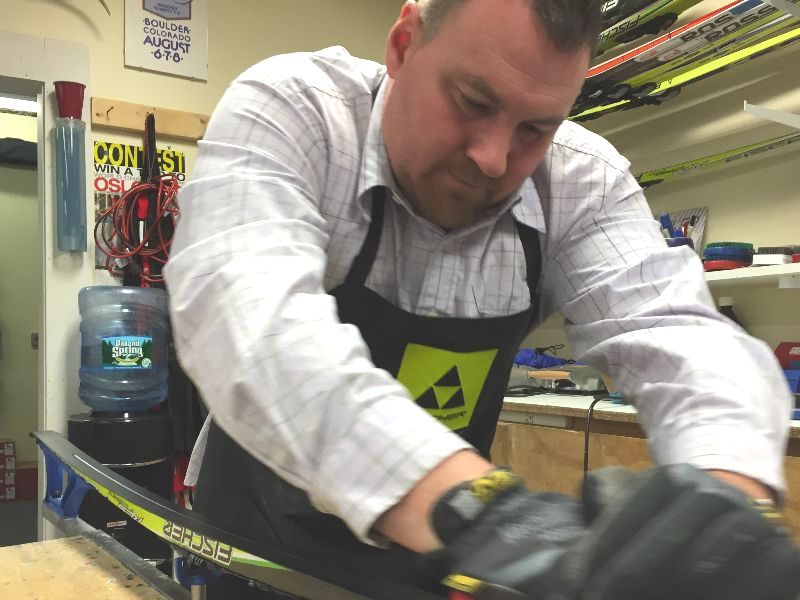
ANCHORAGE, Alaska — The cross-country ski world is remarkably accessible. World Cup winners train with junior skiers. Citizen racers can toe the same starting line as current World Cup skiers. And last month U.S. Ski Team member Jessie Diggins accepted an invitation to go to Norway, where she spent a week at training camp with several members of the Norwegian National Team.
Diggins blogged that she learned new vocabulary words for spongy bog running, thrilled to the presence of a team chef, and marveled at the national media interest in a June training camp. But she wrote that her most important lesson involved the teams’ similarities rather than their differences: “The biggest thing I found out right off the bat was that there really ARE no training secrets – in all the big ways, we train exactly the same as the Norwegians. Which was really awesome (and reassuring) to find out.”
In that same spirit of openness and commonality, check out what the U.S. Ski Team did in a recent workout on the roads near Anchorage’s Kincaid Park as part of their recent Alaska training camp (held in conjunction with local Alaska Pacific University, or APU). Whether you’re a junior skier aspiring to a Junior Nationals team, or a masters skier hoping to move up a wave in next year’s Birkie, chances are that you will find this workout more recognizable than you think.
Which is to say that you too can train like the U.S. Ski Team. Or, by the associative property, like the Norwegians. So take your pick – but keep in mind that, the way the Americans have been skiing as of late, Norway might not even be the sexiest role model here.
The workout that FasterSkier observed last Saturday morning, July 9, was a classic rollerski speed workout: long warmup, 12-15 x 15-second intervals with full moving recovery between each one (3 minutes), cooldown. Not particularly obscure, not esoteric, not rocket science. But here are some specific ways that the U.S. Ski Team coaches and athletes worked together, today and every day, to get the most out of each workout:

1. Actively work to maximize each workout. This may be the guiding principle for the U.S. Ski Team throughout the season. As U.S. Ski Team Women’s Coach Matt Whitcomb told FasterSkier in-person and informally during the workout, at this level (of World Cup racing), everyone is training approximately the same amount, and doing approximately the same things. The real challenge is to figure out how to get that slight extra percentage out of each athlete and each workout.
One way to achieve this is to work to “deliberately engineer each session,” Whitcomb told FasterSkier. For the U.S. Ski Team (USST) on this particular Saturday morning, that meant keeping the focus and priority on the 12 to 15 short speeds that were the point of the workout, and making sure that the athletes could appropriately achieve this stimulus.
“This can be a very different workout depending on the athlete,” Whitcomb told an assembled group of USST members and APU skiers after the workout had been explained and immediately before the athletes set out on their warmup. “Don’t be afraid to go fast or go slow; do what you need to,” in order to keep the workout a set of 15 distinct speeds, not a two-hour fartlek session.
For the citizen racer, this might look like… precisely this: keep the focus on the point of the workout, and do what you need to do to achieve this. Oh, and going easier in your recovery stretches to ensure a full recovery and good form in the next “on” stretch is probably never going to be remiss.
2. Figure out what variables you want to control. Rollerski speed is exceptionally variable, APU Head Coach Erik Flora was explaining to a pair of reporters before the workout began. You need to account for the terrain involved, the lead-in to each interval session, and each athlete’s acceleration or deceleration (in addition to more obvious variables of rollerski model, wheel speed, pavement temperature, and so on). “ ‘Speed’ is not constant” on rollerskis, Flora explained.
With this in mind, when the coaches set out cones to mark the beginning and ending point of each 15-second interval, not all cones were the same distance apart.
The intervals were also chosen with an eye to what the athletes wanted to be working on. For the athletes assembling in west Anchorage on a sunny Saturday morning, their minds were set on Lahti, Finland, and the 2017 World Championships roughly seven months in the future. The Lahti courses are renowned for featuring awkward transitions, including into “running uphills” (on classic skis), and hills an additional 15 to 20 seconds longer than what athletes are accustomed to. So the morning’s interval sections were heavy on awkward transitions, including around corners and from gradual terrain into steep uphills.
For the citizen racer, there’s no reason you can’t do the same. Most of us are presumably not headed to Lahti in February 2017. But most of us do have goal races with specific characteristics. For example, the Birkie is predominantly uphill for the first 13 kilometers. Junior Nationals this year will be held in Lake Placid, N.Y.., which features its own specific and notorious hills. The Western REG Camp previewed the notorious Hermod’s Hill in Soldier Hollow, where World Juniors will be held in January. Figure out what course attributes you want to mimic or what skills you want to work on, and design your workout to address those things.
Most of us are presumably not headed to Lahti in February 2017. But most of us do have goal races with specific characteristics.
3. Start with some video. Before the morning’s session, the athletes watched a three-minute video of World Cup skiers skiing well in the day’s technique. (It was not this video, but one could do worse for a compilation of high-speed doublepole classic skiing. Or just find the feed of a recent World Cup race with a prominent doublepole section, and focus in on an athlete there.)
There was one male skier and one female skier featured in the clip. For three minutes, the room went silent, while the athletes watched the video, and perhaps channeled it.
And apparently it works. There will be moments when Whitcomb is watching an athlete in a workout, he said, and something just clicks, and the athlete starts skiing better. “And I’ll ask, Were you channeling [Ola Vigen] Hattestad there?” Whitcomb said. “And they’ll say, Yes.”
Citizen skiers: also have the internet. Find a race, watch some footage that shows what you want to do, then go out and channel that.
4. Then do the workout. This morning’s workout included a 40-minute warmup on gradual terrain, segueing into the speeds only when the athletes were fully ready. Each speed occurred over an approximately 15-second stretch, which the coaches had marked out ahead of time. Much attention was given to ensuring that there was enough terrain between each speed section to ensure a full recovery… but, as assistant men’s coach Jason Cork finally noted at the end of one particularly long explanation, “We can give them elaborate instructions, but if they need a three-minute recovery, they’ll take it.”
After the final speed, a cooldown followed.
Citizen skiers: There are no secrets here. This is a workout you can do. You will presumably cover less ground in 15 seconds than an elite athlete does – but the neurological stimulus of briefly moving at high speed should be the same.
(For Anchorage-based skiers who want the full USST experience, the heart of the workout took place over the Lucy Street – Skyhills Drive – Jodphur Street – Kincaid Road loop just west of the old Sand Lake gravel pit, which cannot surprise anyone who has ever been rollerskiing in Anchorage. As of early July 2016, Dimond is still closed at Westpark, but the rest of the loop is open, and nearly all of it has gorgeous, smooth, brand-new pavement.)
5. Don’t let the workout end when the workout ends. In one obvious and literal sense, this workout came to an end a little under two hours after it began: the athletes did the warmup, 12 to 15 speeds, and a cooldown, and then it was over. Time for dry clothes, food, and recovery before getting ready for the next workout.
In another sense, as Whitcomb observed, “The workout is in fact longer than just this one hour and 45 minute process.” Coaches took video footage of the workout, from a number of points around the loop course covering all the speeds section. Following the workout, they uploaded it to a secure site, and shared the link with the athletes for their review. Whitcomb was clear that as much as the coaches and athletes work ahead of time to make sure the workout is worthwhile, work can also be done after the workout to ensure that the athlete gets everything possible out of the morning’s session.
Admittedly, this might be the hardest thing for the citizen racer to put into practice. Most of us don’t have one coach who will run a video camera during a workout, let alone three. (This particular joint USST-APU workout featured all of head coach Chris Grover, Whitcomb and Cork in attendance, as well as Flora.)
If you do have video of yourself to review, great. Barring that, at least take some time in the car or bicycle ride back from training to think about the day’s workout, and what went well or not well. Then maybe go watch some more footage. And channel Hattestad some more.
Gavin Kentch
Gavin Kentch wrote for FasterSkier from 2016–2022. He has a cat named Marit.








